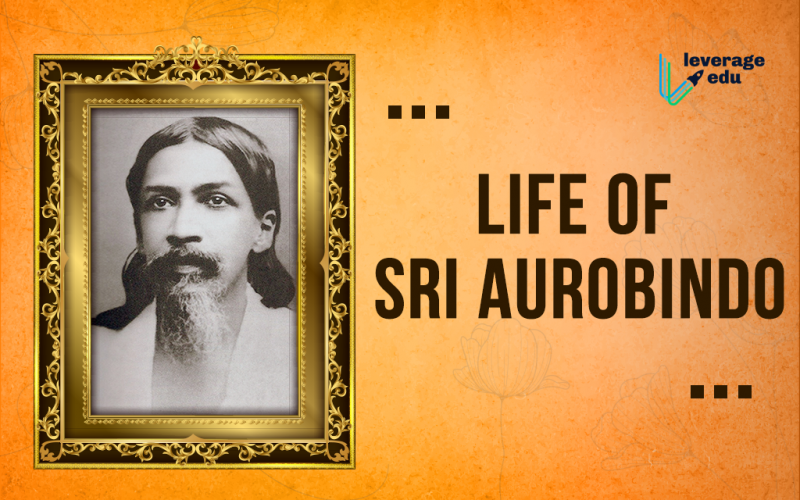Aurobindo Ghose is a well-known international and notable name among the famous personalities of India. He is also renowned for his great national and spiritual leadership. His participation in India’s freedom fight was compact, yet impactful. Aurobindo Ghose fought using his exceptional writings that made an impact on people that enlightened them to participate in independence. His life revolves around how he started promoting independence and evolved to become a yogic guru. In this blog, let’s gain insight into the life of Sri Aurobindo.
Table of contents
Read about Tatya Tope, the Indian Superhero of the Independence Movement
Inspirational Journey Of Sri Aurobindo
Aurobindo Ghose was born in Calcutta on 15 August 1872. When he was 7, his parents sent him to the United Kingdom for his studies. There he studied at St. Paul’s School, London, and at King’s College, Cambridge. When he returned to India, he had already established excellence that brought various accomplishments. In India, he worked as a civil servant under the Maharaja of the Princely state of Baroda. Even though Aurobindo Ghose was involved in politics initially, he went on and demanded complete freedom from the British Government.
He wrote various articles for ‘Indu Prakash’ while he was in the services of the Baroda administration. This helped to get in touch with major resistance groups in Madhya Pradesh. When Bengal got separated in 1906, he moved to Kolkata. Although he supported non-cooperative resistance, he was a member of revolutionary groups in secret. It helped in creating a revolutionary atmosphere in the country.
Aurobindo Ghose played his role in the Indian freedom struggle by getting in touch with young revolutionaries. He also took part in the Indian National Congress annual session, where he showed his support for four objectives of the national movement (Swaraj, Swadesh, Boycott and national education). In 1907, Aurobindo Ghose started his newspaper, Bande Matram. After the split in Congress between moderates and extremists, he supported Bal Gangadhar Tilak who was among the extremists. Then, he travelled among people in Bombay to educate people and gain their support.
Read about the Education of Mahatma Gandhi
From Jail to Divinity
In the year 1908, Aurobindo Ghose was arrested by the police but got released the following year. Even after being in jail, he did not stop writing and continued to make people aware of their independence. After coming out of jail, he began his new publications: Dharma and Karmyogini, in 1909. It is essential to note that when he was in jail, he realized something that helped him in turning towards yoga and internal awakening. Since then, he started focusing more on the spiritual awakening through philosophical and mystical ways.
After the life turning realization, Aurobindo Ghose secretly moved to Pondicherry, a former French colony, to begin his new life. There, he started a new path of spirituality and learned human evolution through integral yoga.
Check out the Revolutions in India You Must Know About
Spiritual Life
After his spiritual realization experiences, Aurobindo Ghose became more focused on developing this idea and promoting it among people. He claimed to hear voices of Vivekananda asking him to begin on the path of spiritualism. In Pondicherry, he dedicated his time and energy to spiritual and philosophical quests. He started Arya, a monthly magazine including his philosophy in 1914.
Slowly, people started realizing the ideas of Aurobindo and started becoming his followers. The numbers kept increasing that led to the formation of Sri Aurobindo Ashram in 1926.
His vision was:
- Independent India
- Resurgence of Asia
- World Union
- The gift of spirituality to the world
- Raising men to a higher consciousness through evolution
Read about the Indian National Movement
Awards And Achievements
Sri Aurobindo Ghose was nominated for the Nobel Prize in the literature category in 1943 and the peace category in 1950. He was nominated based on his indispensable contribution to literature, spirituality and philosophical writings.
Some of his popular works are:
- His major works include Essays on the Gita (1922).
- Collected Poems and Plays (1942).
- The Synthesis of Yoga (1948).
- The Human Cycle (1949).
- The Ideal of Human Unity (1949).
- Savitri: A Legend and a Symbol (1950).
- On the Veda (1956).
Sri Aurobindo Ashram
A large number of people started following him when he moved to Pondicherry where he started spreading spiritualism through his monthly magazine Arya. This led to the establishment of Sri Aurobindo Ashram.
The Ashram was established In 1926 and Aurobindo started using Sri before his name, which means sacred in Sanskrit. Mirra Richard, a French affiliate of Sri Aurobindo in spiritualism, helped in laying down the foundation of Sri Aurobindo Ashram. When Aurobindo went into seclusion, Mirra Richard took charge of the Ashram in 1926. He was given the position of ‘Mother’ and was Sri Aurobindo.
Sri Aurobindo Ghose led a life that helped India in independence and also offered spiritualism to the world. His contribution to the field of literature and spiritualism is remarkable. One can learn a lot from his inspirational and motivational life that helped people in moving to the path of internal awakening. Want to read more such inspiring and motivating real-life stories? Stay tuned at Leverage Edu!

 One app for all your study abroad needs
One app for all your study abroad needs






















 45,000+ students realised their study abroad dream with us. Take the first step today.
45,000+ students realised their study abroad dream with us. Take the first step today.

